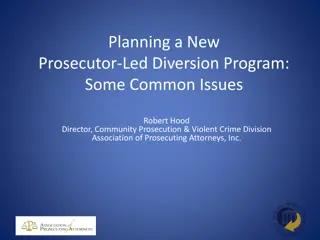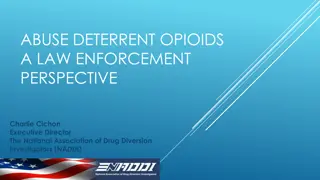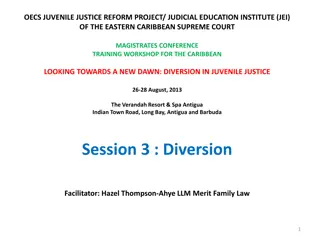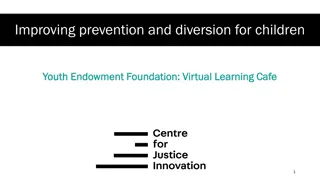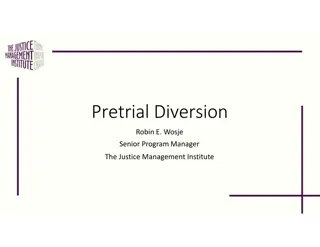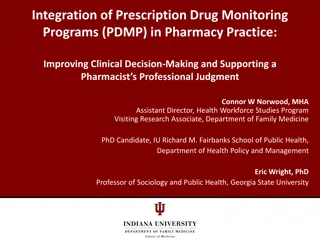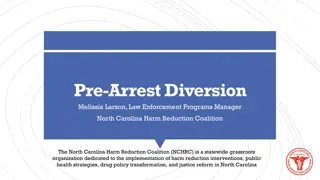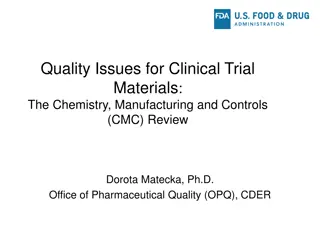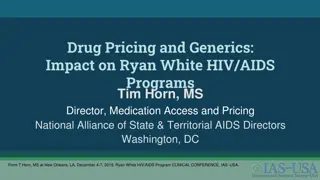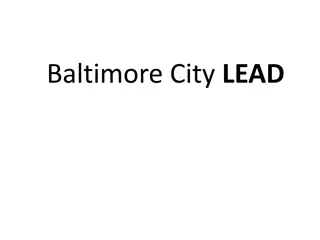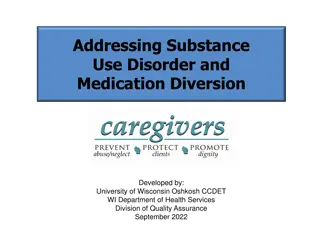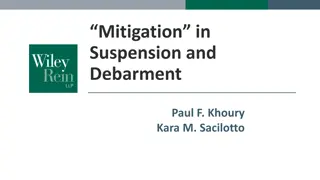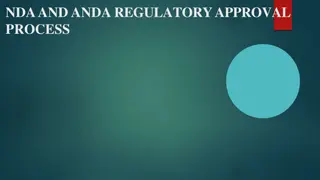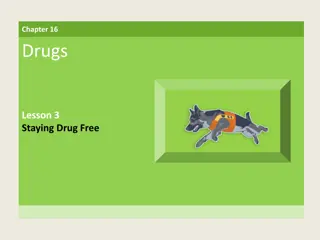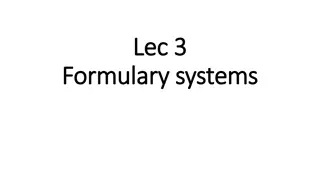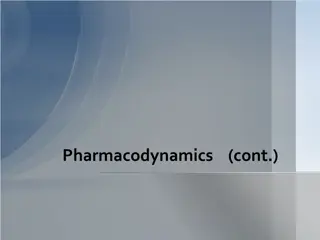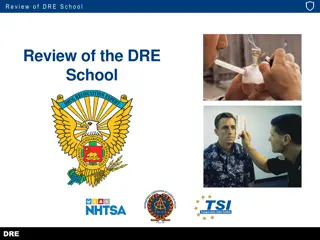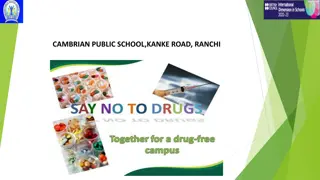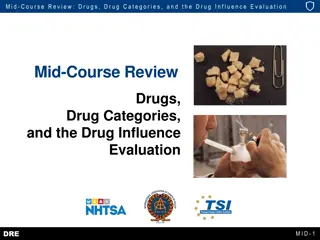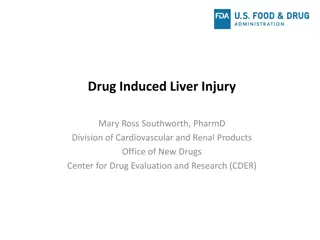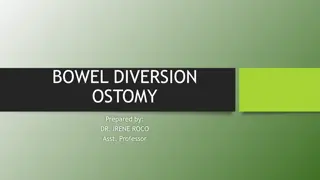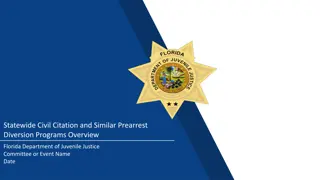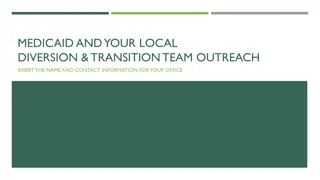Strategies for Mitigating Drug Diversion in Clinical Settings
Strategies for preventing drug diversion in clinical settings are crucial for patient safety and workplace integrity. The presentation by Jesse Breidenbach, Pharm.D., explores successful structures, myths, and the prevalence of drug diversion in healthcare. It emphasizes the need for tight control of narcotics, partnership with nursing, and adherence to DEA requirements to combat drug diversion effectively.
Download Presentation

Please find below an Image/Link to download the presentation.
The content on the website is provided AS IS for your information and personal use only. It may not be sold, licensed, or shared on other websites without obtaining consent from the author. Download presentation by click this link. If you encounter any issues during the download, it is possible that the publisher has removed the file from their server.
E N D
Presentation Transcript
Processes and Partnership with Nursing on Mitigating Drug Diversion in Clinical Settings Jesse Breidenbach, Pharm D Director of Acute Care Pharmacy Sanford Medical Center Fargo
Objectives Define successful structure to prevent drug diversion in a clinical setting 1. Define how tight control of narcotics in a clinical setting protects against diversion a) Organized plan for diversion investigation b) Develop a team approach for diversion investigation c) Describe staff and leadership education d) Describe common reasons supervisors are surprised that an employee is diverting drugs 2. Define the top myths of behavior a) Describe how supervisors should use a team approach to prevent blind spots b)
What is Drug Diversion? The theft of a controlled substance or other medications from the organization s supply, or from a patient s supply, for purposes of self- administration, selling or other use.
Prevalence in Healthcare It s estimated that: Greater than 100,000 healthcare workers (Doctors, Nurses, Medical Technician, Healthcare Aides, etc) are abusing or dependent on prescription drugs in a given year (USA Today report released in April 2014) 1 in 10 physicians develop problems with alcohol or drugs at some point during their careers (Patrick Skerret, Director Harvard Health) 10-15% of all nurses may be impaired or in recovery from addiction
Impact on the Workplace Patient Care & Safety Patient Satisfaction Lost Productivity Poor Decision Making Safety Risk Decreased Morale Bottom Line
Prevention of drug diversion in a clinical setting DEA requirements DEA form 106 Federal regulations require that registrants notify the DEA Field Division Office in their area, in writing, of the theft or significant loss of any controlled substance within one business day of discovery of such loss or theft. The registrant shall also complete and submit to the Field Division Office in their area, DEA Form 106, "Report of Theft or Loss of Controlled Substances" regarding the theft or loss. (21 C.F.R. 1301.76(b)) https://www.deadiversion.usdoj.gov/21cfr_reports/theft/
Prevention of drug diversion in a clinical setting Defined process for ordering, receiving, restocking and dispensing controlled substances (CS) Limited access to ordering CSOS/DEA 222 forms Receiving Person placing CS order does not receive/check in CS order CS stored in narcotic vault in pharmacy Restocking Narcotic vault communicates with automated dispensing cabinets CS removed from vault for restocking creates an open loop Loop is closed when the cabinet has that narcotic restocked Loops can be closed manually but not by the person that opened the loop (monitored) Dispensing CS Primarily via automated dispensing cabinets Enables extensive tracking and documentation of access Non-automated dispenses Maintain chain of custody
Prevention of drug diversion in a clinical setting Tight control of controlled substances is necessary to prevent diversion Documentation of what was done with the CS Security locked or under constant supervision ADCs often used for most frequently used Enforced by policy and auditing to policy requirements Auditing can be very time consuming Policies need to support best practices and be enforced Decision support/data review Identify potential diverters
Prevention of drug diversion in a clinical setting Nursing CS workflow Order for CS received, verified and on patient MAR Nurse obtains CS for administration CS typically dispensed from automated dispensing cabinet (ADC) If dose = full vial/syringe Nurse removes CS from ADC Nurse administers CS via barcode med administration (BCMA) on MAR If dose = partial vial/syringe (best practice waste before administration) Nurse finds witness CS removed from ADC with witness Nurse draws up dose with witness Nurse wastes portion of CS not needed with witness (documents waste in ADC prior to administration) Nurse administers dose via BCMA CS should be fully accounted for (waste, and administration should = what was removed)
Prevention of drug diversion in a clinical setting Nursing CS workflow (continued) Time constraints around administration CS must be administered within 30 minutes after obtaining/removing CS from ADC Documentation of waste is required to be completed within 30 minutes of administration If this does not happen concerns over where the CS is being stored If CS removed but not administered a witnessed waste (opened product) or return (intact product) must happen within 30 minutes of the removal from the ADC Chain of custody Nurse removing CS from ADC or obtaining CS from pharmacy is responsible for what happens to the CS Nurse removing from CS should be administering nurse whenever possible ADC discrepancy resolution Charge nurses only (tightened this practice) Need to know what actually happened to cause the discrepancy not just clearing the discrepancy off of the cabinet If unable to determine what happened submit an event report
Prevention of drug diversion in a clinical setting Best practice minimizes opportunity for diverting Best practice allows the witness to verify drug and amount being wasted Best practice witness should see the vial opened or the syringe removed from it s tamper evident packaging Exceptions to best practice (a witness is not immediately available) A witnessed waste is expected to occur within 30 minutes of the administration In this case the witness can only confirm volume of waste not actual drug being wasted Procedural areas Documentation of all waste within 30 minutes of completion of the case
Prevention of drug diversion in a clinical setting Pitfalls Chain of custody Jenni, RN removes fentanyl from ADC for patient X to be administered by Mike, RN Jenni hands Mike the fentanyl and does not observe the administration of the CS CS audit reveals that not all fentanyl is accounted for and patient Xs clinical condition did not warrant fentanyl administration CS removal is tracked back to Jenni as she removed the fentanyl from the ADC Who is responsible for the fentanyl Only remove medications for patients assigned to you Do not hand off CS to other staff Missing drug or missing documentation Audit reveals that 4mg of morphine removed for patient Y MAR audit reveals that 3mg of morphine documented as administered for pain score of 8 No documentation for missing 1mg of morphine Is this missing drug or missing documentation?
Organized Plan for Diversion Investigations Have sound institutional policy regarding drug diversion Input from nursing, pharmacy, legal, risk, providers and administration/HR Supports best practices Policy provides basis for corrective action Use of a checklist that follows policy Help guide the investigation Keeps investigating team on the same page Difficult to navigate investigation if you have not been involved in one in the past Leadership turnover Timing of the investigation and potential meeting with staff being investigated Call the staff person in on day off or wait until their next scheduled shift What happens to the employee during this time limiting access to drugs/ADC access Cover staffing if you don t plan to have them staff after meeting
Organized Plan for Diversion Investigations Accurate data from a reliable source CS logs and chart information MAR administrations ADC dispensation, waste and return documentation ADC reporting and diversion scoring HBI data third party data analysis Observation of control/wasting practices Employee pledge Documented observation of best practices being followed Work and communication performance Often discussed during investigating team meeting and/or with staff being investigated When is it beneficial use of a Drug screen Pros and cons of drug screening related to diversion Diverting for self or possibly for others Easy to have diversion without an impaired professional
Audit Potential Diverters Report Unit Drill Down
Audit Potential Diverters Report Unit Drill Down
Audit Potential Diverters Report Unit Drill Down
Diversion Checklist Review: Potential diversion identified by reports/audits, employee performance/behavior, positive reasonable suspicion results. Pharmacy notifies Manager and Director if a potential diverter is identified through audit. I. Director/Manager contacts HR Director II. Director/Manager organizes meeting to review and discuss findings III. Determination made to meet with employee to share findings IV. HR and Manager organizes meeting with employee (logistics of place, time, etc., i.e. a room away from employee's work area, time is as soon as possible) V.
Diversion Checklist Review: Manager calls employee to schedule a meeting as soon as possible. If working, removed from work area immediately (not allowed to work during interim of initial investigation meeting and meeting with the employee) VI. VII. Director and Manager determine if suspension (with or without pay) is needed VIII. Manager to meet employee and escort to meeting location. The purpose is to confront the employee with evidence regarding suspected diversion. Employee Meeting to review suspected diversion Termination (if applicable), Follow Up IX. X.
Team Approach For Diversion Investigation An educated/experienced core team is key It should have at the minimum Nursing Practice, HR, Pharmacy, Risk and a like provider if appropriate The core team should be well versed in the reading /analyzing the data ability to ask hard questions seasoned leaders understand appropriate regulations be able to respond on a short notice to support the direct supervisors Needs to be a priority when diversion is suspected The team develops an action plan with the direct supervisor and see that the plan is carried out The team is a support system for the direct supervisor and is also responsible to see that the employee is fairly treated
Team Approach For Diversion Investigation Set up Drug Diversion Mitigation Committee to meet on an on going basis: CMO, CNO, Risk, Office of Nursing Practice, Security Director, Legal, HR, Anesthesia, Pharmacy
Diversion Checklist Roles Created to assist as needed with potential diversion situations Working document
Staff And Leadership Education Leaders are often na ve about the consequences and prevalence of addiction issues Both regulatory and policy need to be thoroughly discussed and review Leaders need a structure to rely upon to be sure that all aspects are covered education on process flow or checklist approach is important Leaders and staff needs to understand signs and symptoms of an impaired coworker Why some signs may actually fool you Staff need to know how to reach out and speak up about concerns Staff need to have clear understanding/expectations competency assessed on a regular basis on CS policies and procedures
Staff And Leadership Education All nursing staff educated All nurses validated on appropriate wasting and chain of custody for CS All nursing management educated Supervisors through directors What is diversion Policy review Diversion team/checklist Identification of resources - Physician executive council educated - Anesthesia department educated
Leadership Expectation Understand the issue from a Patient Safety Viewpoint Use a balanced team to scope, analyze issues and agree on a plan forward Be open to the fact that you might be blind sided Be open to examining work flows that are preventing best practices and changing them
Common reasons for not identifying diversion Top myths of staff diverting CS A person with addiction is very smart, wants to work, and wants to stay in good standing These characteristics help keep them in proximity to drugs, because these behaviors keep the employee under the radar or out of trouble These employees are often very helpful They offer to run and get things They offer to run to give meds to your patients They offer to run to pharmacy to pick up a drip These behaviors keep them valuable to their team members There is a less likely chance someone would report odd behavior when they like the person (the person is being helpful )
Why dont we see it? Award Winners Techs, Providers, Nurses New Grads Pregnant Healthcare Workers Pharmacists, Aides Team Leaders
Signs and Symptoms Emotionally Aggression, anxiety, paranoia, defensive Behaviorally Increased absence/availability to pick up shifts, unsteady, slurred speech, irritable, overly helpful i.e. I ll pull your meds for you Physically Weight loss, sweating, smell of alcohol, pinpoint pupils or glassy-eyed, lethargic
How Supervisors Should Use A Team Approach To Prevent Blind Spots Supervisors are invested in staff they hire They support and want to believe they made a good choice to hire the person They might develop personal relationships with staff (inside and outside of work) Supervisors like being fully staffed Dealing with the issue may mean a gap in schedule Cases where diverting staff has been working a lot/picking up shifts Because of these blinders, Supervisors need a team of objective and multi- disciplinary leaders to help drive the investigation and planning These are hard conversation so having a team approach gives the directors and supervisors support in the actual meetings and interventions
Resources: Road Map to Diversion Prevention: http://www.health.state.mn.us/patientsafety/drugdiversion/divroadmap04181 2.pdf http://www.nursingworld.org/DocumentVault/Position-Statements/Drug-and- Alcohol-Abuse/pos.html DEA Office of Diversion Control: https://www.deadiversion.usdoj.gov/index.html NCSBN Substance Abuse Disorder in Nursing: https://www.ncsbn.org/index.htm Substance Abuse and Mental Health Services Adminis-tration. (2010). Results from the 2009 National Survey on Drug Use and Health: Volume I. Summary of National Findings (Office of Applied Studies, NSDUH Series H-38A, HHS Publication No. SMA 10-4586 Findings). Rockville, MD. Hansen RN, Oster G, Edelsberg J, Woody GE, Sullivan SD (2011). Economic costs of nonmedical use of prescription opioids. Clinical Journal of Pain 27(3): 194-202.


